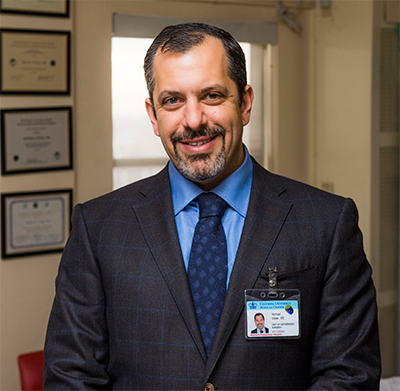The incidence of surgical site infection (SSI) in pediatric spinal deformity continues to remain high in the United States – reported to range up to 26.3 percent – despite considerable efforts to reduce the number. Predictive models for SSI previously published have had major limitations in methodology primarily due to a paucity of clinical data and few participating institutions.

Dr. Michael Vitale
To this end, Columbia University pediatric orthopedic surgeons recently conducted a multicenter study to evaluate a wide range of preoperative and intraoperative factors in predicting SSI. Under the leadership of Michael G. Vitale, MD, MPH, Chief of Pediatric Spine and Scoliosis Surgery in the Department of Orthopedic Surgery at NewYork-Presbyterian/
The retrospective cohort study involved 3,092 spinal deformity procedures from a database of patients aged 0-21 years across seven institutions who underwent primary, revision, or definitive spinal fusion from 2004 to 2018. Candidate risk factors in the study included 31 patient, 12 surgical, and 4 hospital factors that were present or determined before the surgery and unlikely to be modifiable.
The final prediction model incorporated 10 risk factors:
- Overweight/obese
- Neuromuscular etiology
- American Society of Anesthesiologist Physical Status Classification System (ASA) >1
- Non-ambulatory status
- Abnormal hemoglobin level
- High white blood cell count
- Revision surgery
- Presence of pelvic instrumentation
- Procedure time ≥7 hours
- <100 spine surgical cases per year per institution

Their findings, which were published in the November 30, 2021, online issue of Journal of Bone and Joint Surgery (Am), included:
- 132 cases of SSI (4.3 percent) were identified among the 3,092 spinal deformity surgical procedures reviewed
- Surgical factors associated with SSI included type of surgery, surgical approach, pelvic instrumentation, number of instrumented levels, type of instrumentation, transfusion, and procedure time
- Multilayered closure was performed in approximately half of the cases followed by topical vancomycin in some 40 percent of patients
- Povidone-iodine irrigations and enrollment in Comprehensive Unit-based Safety Program/Solutions for Patient Safety programs were present in approximately one-fourth of patients
- Adherence to postoperative dosing of antibiotic prophylaxis was 78.3 percent and postoperative timing ranged from 87 percent to 89.5 percent
- Use of povidone-iodine irrigations and enrollment in the Comprehensive Unit-based Safety Program/Solutions for Patient Safety programs were associated with a decreased risk of SSI
The final risk probability calculator, including patient, surgical, and hospital factors, predicts the probability of 90-day SSI in pediatric spinal deformity surgery. “The results of this study will enable healthcare providers to calculate the risk of SSI and the effects of preventive strategies in reducing that risk,” notes Dr. Vitale. “In the long term, this information could be used to enhance personalized care in clinical practice to prevent SSI, as well as to facilitate patient education and shared decision-making and may allow the deployment of additional resources and strategies selectively in high-risk patients.”



